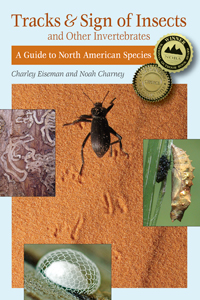One of the reasons certain nonnative plants come to dominate the landscape is that they are released from the specialized insects and pathogens that keep them in check in their native range. So I’m always interested to see what insects are able to make use of these plants. I’ve often noticed little nibbles like this on Japanese barberry (Berberis thunbergii)…

…but had never actually spotted anything feeding on the leaves until one autumn day when I stopped to investigate some particularly fresh-looking nibbles. This “window feeding” (leaving one epidermis intact) turns out to be the work of early instars of an inchworm, which starts eating all the way through the leaves as it grows larger.

The above photo was taken on September 28. Here is the same caterpillar on October 2…

…and October 8:

The caterpillar burrowed into soil not long after this, emerging as an adult in March after I took its jar out of the fridge.

Its patterned wings became good camouflage when it came to rest on the fallen white pine in my yard:

This native moth is known as the barberry geometer (Geometridae: Coryphista meadii), and barberries are its only known host plants. Its original host is presumed to be American barberry (Berberis canadensis), but this plant does not occur in the Northeast. So like Stigmella rhamnicola (but even more dramatically), this moth has expanded its range because of the introduction of a nonnative plant. Sorry to say the little nibbles made by the caterpillars aren’t enough to keep the barberry from taking over places where the deer are selectively eating all the other understory plants.
Last October I discovered that barberry geometers aren’t the only caterpillars feeding on leaves of Japanese barberry. Whereas the inchworms “window feed” from the lower leaf surface, I found these two caterpillars grazing in little patches on the upper leaf surfaces:


These are the same two caterpillars a week later:


Five days later, they looked much more similar to one another:


Unfortunately I was unable to rear these to adults. I have found similar caterpillars feeding on Christmas fern (Polystichum acrostichoides) and wintergreen (Gaultheria procumbens) in the fall, so I think this is just a species that feeds on whatever is still green at the end of the year rather than any kind of barberry specialist. It’s some sort of owlet moth (Noctuidae); I had one of the wintergreen feeders emerge in June, but I haven’t figured out what it is yet and I’m nowhere near there in my photo sorting, so stay tuned…




Charley…It’s always like Christmas morning when one of your posts arrives in my mailbox. I pore over all the text, inspect every photo, and excitedly share my new knowledge with family and friends. There’s always something new and fascinating to contemplate.
Thank you for your keen eye and careful observations
This is fascinating stuff. I found a barberry geometer on my property, 2012-07-25, having a japanese barberry here in Farnham, Quebec. Also an ornamental barberry “Rosy glow” not a rust intermediary. To see a photo I took here is the link :https://www.facebook.com/photo.php?fbid=1097345120311530&set=a.197104963668888.45850.100001081581989&type=3&theater
Thanks for you wonderful articles and photography. I just love them